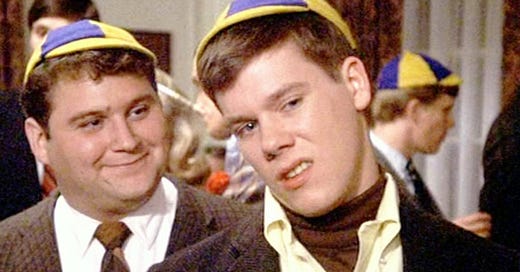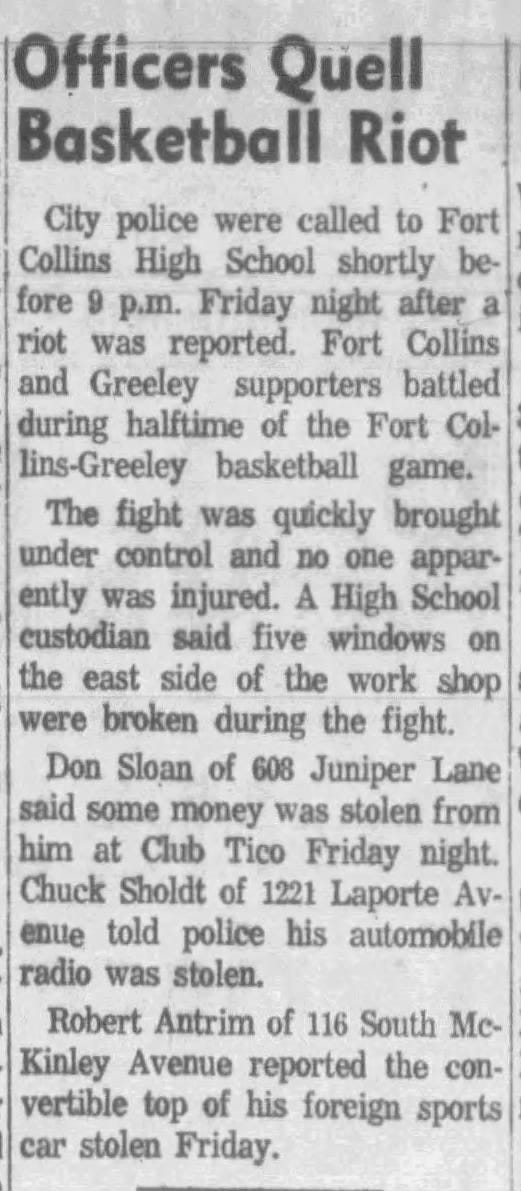Bacon's Law: Six Fun Facts for Six Kyan Evans 3-Pointers
Six 3-pointers from Kyan Evans and six steps to famed actor Kevin Bacon.
Bacon’s Law dictates that a connection exists between any mainstream Hollywood actor and Kevin Bacon within six films or fewer. In honor of Kyan Evans knocking down a career-high six 3-pointers to lead No. 12 seed Colorado State past Memphis in the 1st Round of West Regional play, here are six facts connecting the Rams to Mr. Bacon himself.
It’s not an exact replica of the beloved Six Degrees of Kevin Bacon game, but hey, I hope you enjoy the gimmick all the same.
Colorado State became the 57th No. 12 seed to beat a No. 5 seed since the 1985 NCAA Tournament
March Madness offers very few certainties, and that’s why we love it. Among the few near-guarantees this time of year, however, is that we’re much more likely to see a No. 12 seed beat a No. 5 seed than not.
It’s become such a staple of March Madness that my tinfoil hat tells me the selection committee leans into the bit with some iffy seeding.
To wit, Colorado State had a resume worthy of at-large consideration before it won the Mountain West Conference’s automatic berth, yet the Rams were seeded on the 12-line with auto-qualifiers from one-bid leagues: Liberty (Conference USA), UC San Diego (Big West), and McNeese (Southland).
What’s more, sportsbooks actually had Colorado State as a 1.5-point favorite over Memphis, not underdogs. Now, I’m hardly one of those goofs who believes bookies should have any involvement with seeding the Tournament, but an “upset” does lose some of its value when it’s not really an upset.
Nevertheless, and despite star forward Nique Clifford going 3-of-13 from the floor, Kyan Evans created the first March Madness Moment of 2025 with his 6-of-9 3-point shooting and 23 points.
Remarkably, Colorado State is the first 12-seed under the Mountain West banner to knock off a five. This is more familiar territory for Memphis, however: With three losses to No. 12 seeds as a No. 5, the Tigers moved into second place for the most 5-12 defeats behind Virginia, which has done the dance five times:
1986 vs. DePaul
1987 vs. Wyoming
2001 vs. Gonzaga
2021 vs. Ohio
2023 vs. Furman
Before either ever won an NCAA Tournament game, Colorado State and Memphis lost to the same NAIA opponent
Sharing historical tidbits I learn with you ranks among my primary motivations in producing this newsletter. Sports history is so rife with interesting nuggets, I’m constantly discovering facts I never knew. For example, present-day NAIA member Oklahoma City University had a strong basketball program in what is today the Div. I level.
Now that I know a little more about its NCAA Tournament history, OCU being a blind spot for me is somewhat embarrassing. The Stars reached Regional finals in both 1956 and 1957. In ‘57, OCU knocked off Loyola University (present-day Loyola Marymount) and Saint Louis to set up an Elite Eight matchup with Wilt Chamberlain’s Kansas Jayhawks.
Oklahoma City’s strategy to contend with Wilt, sending him to the free-throw line for 22 attempts, didn’t pay off. Chamberlain scored 30 points to go with 15 rebounds against Oklahoma City’s own future NBA big man, Hub Reed. Kansas ended OCU’s national championship dreams, 81-61.
A year prior, OCU lost a similarly lopsided Regional final to SMU—but not before putting up more than 90 points in wins over Kansas State and then-Memphis State. Reed went for 27 points on 10-of-14 shooting from the floor.
OCU’s 97-81 defeat of the Tigers ended Memphis’ second-ever trip to the NCAA Tournament abruptly, one year after Penn State sent them packing.
While Oklahoma City did not go as far as the Elite Eight again after 1957, the Stars won NCAA Tournament games twice more—both over Colorado State.
OCU outscored Colorado State in the second half, 39-25, in a 70-67 Stars win. Bonus fact: The same night as the OCU-CSU matchup, a high school basketball game between Fort Collins and Greeley was interrupted when attendees rioted.
Colorado State and Oklahoma City met again two years later with a nearly identical result: 70-68 Stars on a Charlie Hunter buzzer-beater.
Oklahoma City returned to the NCAA Tournament twice more, first in 1966 as the first opponent that Don Haskins’ famed Glory Road Texas Western bunch beat on the way to the national championship, and then in a blowout loss to Arizona State in 1971.
OCU reclassified as an NAIA member in the late 1980s and won six national championships from 1991 through 2008.
Colorado State, meanwhile, picked up its first-ever NCAA Tournament win in 1969 when it beat Dayton and later Colorado on a run to the Elite Eight. More on that in a moment.
This is Colorado State’s first NCAA Tournament win since beating Missouri in 2013
After Missouri won the 2012 Big 12 Tournament championship, Tigers fans drowned out the trophy presentation with college sports’ most obnoxious chant: “S-E-C!”
Tribalism’s rallying cry provided a proverbial middle finger to the successor of a conference Missouri joined in 1907. It was also one of the few celebratory moments for MU basketball in the last 13 Marches.
The Tigers ended their time as Big 12 members with a loss to 15-seeded Norfolk State, one of five straight 1st Round exits for Missouri from 2011 through 2021, including falling in its first year as an SEC program to Colorado State, 84-72.
MU got off the opening-round schneid in 2023 when it beat Utah State, but bowed out to 15th-seeded Princeton.
With Thursday’s 67-57 loss to No. 11 seed Drake, Missouri is 1-6 in NCAA Tournament games since that notorious S-E-C chant, with all six losses coming against opponents seeded No. 8 or lower.
Drake’s win over Missouri marks the Bulldogs’ first time advancing1 in the modern era of March Madness
Drake first appeared in the NCAA Tournament in 1969 and made an immediate splash with a run to the Final Four.
The Bulldogs cruised past Texas A&M in the Round of 16, then topped Colorado State in the Regional final, 84-77. That set up a showdown with UCLA at the height of John Wooden’s powers, with the Bruins having won four of the previous five titles going into the 1969 NCAA Tournament.
Kareem Abdul-Jabbar was in his final season at UCLA, putting up 24 points on 63.5 percent shooting from the floor, with 14.7 rebounds per game. Kareem registered double-doubles in every NCAA Tournament of his college career, including a staggering 24 points and 21 rebounds against Drake.
However, the Bulldogs gave UCLA all it could handle in an 85-82 semifinal. Drake finished third in that Final Four, blasting North Carolina in the consolation game, 104-84. Given that in the National Championship Game, UCLA blew out Wooden’s alma mater, Purdue, it’s safe to declare Drake the second-best team of that postseason.
Drake advanced to the Elite Eight the next year, then didn’t return to the NCAA Tournament again until 2008. This season marked the Bulldogs’ fourth appearance in five years, including being well-positioned as a trendy No. 12 seed poised for a win against Miami in 2023 before the Hurricanes’ surprise Final Four run.
Bennett Stirtz’s 21-point effort against Missouri matches Willie McCarter’s team-high when the Bulldogs beat Colorado State in the 1969 Regional.
North Carolina’s loss to Drake in 1969 was one of four straight Final Four losses for the Tar Heels in a skid that ended in 1972
North Carolina reached the Final Four three times from 1968 through 1972 and lost four consecutive games in that stretch.
For those failing to compute the math, this came at the tail-end of the era of Third-Place Games. Thus, the ‘68 Tar Heels lost to UCLA in the National Championship Game, and a year later, Carolina lost to Purdue and Drake by 47 combined points.
There was a point in the 2025 Tournament where the Heels appeared headed to a 47-point loss to Ole Miss.
Anyway, the skid continued with North Carolina’s return to the national semifinals in 1972. The Tar Heels fell to future ACC counterpart Florida State, 79-75, before going out on a high note in the consolation game vs. Louisville.
Bob McAdoo completed a sensational NCAA Tournament with 30 points and 19 rebounds against the Cardinals. He put up double-doubles in 3-of-4 games that postseason, going for 82 points and 56 boards for the tournament.
Speaking of…
Bob McAdoo was the basketball consultant for the 1994 Kevin Bacon basketball film, “The Air Up There”
Could this exercise have taken a far less circuitous route? Uh, yeah.
The 2025 NCAA Tournament features 5-12 matchups that include Colorado State vs. Memphis and Liberty vs. Oregon; the University of Oregon campus was the primary filming location of Animal House, featuring a young Kevin Bacon.
Alright, but that isn’t the jumping-off point for six historical facts—nor does it allow for a shoutout of Kevin Bacon’s turn as a college basketball coach in the 1994 comedy The Air Up There.
A surprising number of college basketball-themed films hit theaters in the mid-to-late ‘90s, with The Air Up There arriving the same year as Blue Chips. Bacon’s Jimmy Dolan would have been a helluva lot more fun to play for than Nick Nolte’s Pete Bell from Blue Chips. Dolan was certainly the better recruiter, playing in a high-stakes basketball game to save the African village of prospect Saleh, while Bell timidly leaned into NCAA violations.
Then again, Bell did land a signing class that included Shaquille O’Neal and Penny Hardaway. And, once more, we have a much more direct line to Colorado State’s win over Memphis and Kevin Bacon by way of Tigers coach Hardaway. But I digress.
Anyway, Tar Heel great and NBA Most Valuable Player Bob McAdoo provided consultation on basketball scenes for The Air Up There, contributing to the film having better action sequences than a fair number of sports films to this day.
McAdoo also helped connect the film’s co-star, Charles Gitonga Maina, with actual college basketball coaches. Maina landed at Div. II Lynn University in Florida shortly after The Air Up There premiered.
Drake won an NCAA Tournament game in 2021, technically advancing out of the First Four, but had not won in the full field in the modern era.






Good knowledge, Kyle!